Hunan boasts not only delicious cuisine and captivating scenery, but also unique folk culture. For thousands of years, the Han nationality has coexisted with ethnic minorities such as the Tujia and Miao on this land. Over the course of history, a profound, diverse, and rich folk culture with strong Hunan characteristics has emerged, forming a splendid "intangible cultural heritage scroll" of Hunan.
Hunan embroidery/ Xiang embroidery(湘绣)
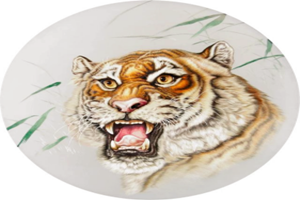 Hunan embroidery
Hunan embroidery
Xiang embroidery, one of the four famous embroideries in China, is a general term for Hunan embroidery products with distinctive Xiang and chu cultural characteristics centered in Changsha, Hunan Province. Originating from folk embroidery in Hunan, it has developed by absorbing the advantages of Su embroidery and Yue embroidery, with a history of over 2,000 years. Xiang embroidery is characterized by its rich gradation of colors and embroidery resembling paintings, earning it the folk saying of "Su cats and Xiang tigers." The fur patterns of lions and tigers in Xiang embroidery are robust and upright, with vivid eyes, almost indistinguishable from the real thing.
Flower Drum Opera(花鼓戏)
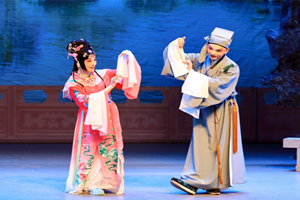 Flower Drum Opera
Flower Drum Opera
Flower Drum Opera is a type of local Chinese opera, primarily spread in Hunan, Hubei, Anhui, Zhejiang, and other regions. Among the various local opera styles known as "Flower Drum Opera," Hunan Flower Drum Opera enjoys the widest circulation and greatest influence. It is a general term for various Flower Drum Opera schools across Hunan, roughly divided into six categories: Changsha, Changde, Yueyang, Shaoyang, Hengyang and Lingling Flower Drum Operas. The music is extremely rich, with a diverse array of repertoires and styles. The opera combines with local languages, forming distinctive school singing styles and accompaniment music with distinct regional characteristics.
Miao's Drum Dance in Xiangxi (湘西苗族鼓舞)
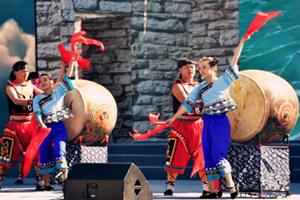 Miao's Drum Dance in Xiangxi
Miao's Drum Dance in Xiangxi
Miao's Drum Dance, a traditional dance form, is prevalent in Jishou City, Fenghuang, Luxi, Baojing, Huayuan, and Guzhang counties within the Xiangxi Tujia and Miao Autonomous Prefecture in Hunan Province. This dance originated before the Han Dynasty, emerging from the sacrificial activities of the Miao people. Over time, the Miao Drum Dance has become the most beloved dance art form among the Miao people.
The Xiangxi Miao's Drum Dance boasts a diverse range of styles, numbering over a dozen. Commonly seen are the Flower Drum Dance, Monkey Drum Dance, Female Solo Drum Dance, Male Solo Drum Dance, and Reunion Drum Dance. These dances are distinctive in their characteristics: performers play the drums while dancing, with lively rhythms, alternating hands to strike the drums, switching feet to jump, and swaying the whole body gracefully. The Monkey Drum Dance is agile and humorous, the Flower Drum Dance is graceful and charming, the Male and Female Drum Dances are bold and vigorous, the Female Solo Drum Dance is flexible and expressive, and the Reunion Drum Dance is grand, lively, and joyful.
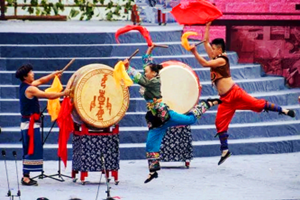 Miao's Drum Dance in Xiangxi
Miao's Drum Dance in Xiangxi
Miao's Drum Dance in Xiangxi has a long history. During the struggles against foreign forces, the Miao’s drum horns played a crucial role in rallying and motivating the people, fostering a profound sense of national unity. The Miao’s drum has become a sacred object for the Miao people in Xiangxi. Since ancient times, the performance of the Miao’s Drum Dance has embodied the Miao people's devout faith and their national spirit of creativity, perseverance, and courage.
Tujia Hand-waving Dance(土家族摆手舞)
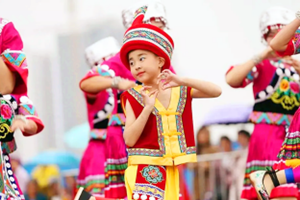 Tujia Hand-waving Dance
Tujia Hand-waving Dance
Tujia Hand-waving Dance in Xiangxi is a folk dance with the most distinctive Tujia ethnic characteristics and one that best reflects the ancient customs of the Tujia people. It is now mainly prevalent in Longshan, Baojing, Yongshun, and other places in Xiangxi, Hunan. It is typically performed from the third to the fifteenth day of the lunar New Year. The Hand-waving Dance originated from the ancestor worship rituals of the Tujia people and has a history of nearly a thousand years.
The dance integrates singing, dancing, music, and drama, portraying a wide range of historical and social life content such as the creation of the universe, human reproduction, ethnic migrations, hunting and fishing, sericulture, slash-and-burn farming, ancient wars, myths and legends, as well as daily life and dietary habits. The dance movements are generous and bold, including single-hand swaying, double-hand swaying, circular swaying, and swaying while dancing. The dance is typically performed on flat ground.
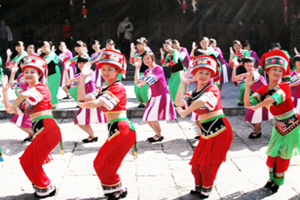 Tujia Hand-waving Dance
Tujia Hand-waving Dance
The Tujia Hand-waving Dance holds significant value in studying the history, wars, religion, migrations, production, daily life, love, and folk customs of the Tujia people. The war content depicted in the dance embodies the national spirit of the Tujia ancestors, who were brave and resilient in battle, unafraid of sacrifice. Additionally, the Hand-waving Dance recreates the entire process of the Tujia people's farming life, reflecting their optimism, love for hard work, perseverance in overcoming difficulties, enthusiasm for life, and resilience in survival. It serves as an essential way for understanding and studying Tujia culture.
Changde Silk Strings(常德丝弦)
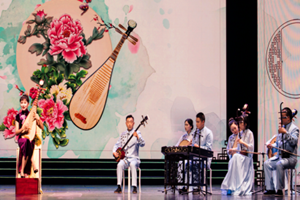 Changde Silk Strings
Changde Silk Strings
Changde Silk Strings is an important branch of Hunan Silk Strings, a genre of Hunan music. Due to its most advanced development and significant influence among Hunan, it has already gained the status of an independent genre. Popular in various regions of Hunan, it is named for its accompaniment by string instruments such as dulcimer, the Chinese lute (pipa), yueqin, three-string fiddle, erhu, and jinghu. Originating from the integration of folk tunes from the regions of Jiangsu and Zhejiang that flowed into Hunan and local folk melodies in Hunan, it occurs approximately in the early Qing Dynasty.
This genre is performed in the Hunan dialect, with the traditional performance form involving multiple performers sitting in a circle, each holding a different string instrument, and taking turns to sing and recite. Changde Silk Strings boasts over a hundred traditional repertoires, most of which are based on historical stories and folk legends. After the founding of the People's Republic of China, a new batch of repertoires reflecting real-life situations emerged. It has distinctive local characteristics and rustic flavor, and is of high artistic value.
Construction Skills of Tujia Stilted Building Group (Diaojiaolou)
(土家族吊脚楼建造技艺)
 Diaojiaolou
Diaojiaolou
The construction skills of Tujia Stilted Building Group, a traditional handicraft with ethnic characteristics created by the Tujia people in their long-term social life, are hailed by experts and scholars as a "living fossil" of ancient architecture. The construction of Tujia Stilted Building Group (Diaojiaolou) originated from the Spring and Autumn and Warring States periods and flourished during the Tang and Song dynasties. After the Peng regime ruled over Western Hunan, Diaojiaolou began to develop comprehensively. During the reign of Emperor Yongzheng of the Qing Dynasty, it became widely distributed. After the founding of the People's Republic of China, with significant improvements in people's living conditions, its construction skills reached their peak, involving numerous procedures, with the main house built on solid ground, and the side rooms connected to the main house on one side while the other three sides are suspended in the air.
Tujia Stilted Building Group not only boasts a unique structure and lively form, but also serves as a precious folk art crystallization that integrates architecture, painting, and sculpture, representing a remarkable example in the history of Chinese architectural art.
Nanyue Temple Fair(南岳庙会)
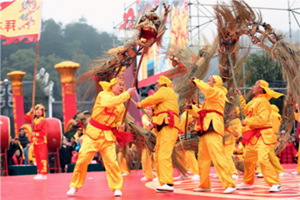 Nanyue Temple Fair
Nanyue Temple Fair
The Nanyue Temple Fair, whose formation dates back no later than the Southern Song Dynasty, reached its peak in the Ming and Qing dynasties and flourished after the 1990s. It is prevalent in Xiang and Chu regions, as well as other parts of China where there is a cult of Zhu Rong, the Fire God. The main venues for the Nanyue Temple Fair are the Nanyue Temple, Zhu Rong Hall, and Tianfu Temple. The main folk activities include praying for blessings and longevity, driving away evil spirits and disasters, and participating in folk performances (Shehuo) and festivities.
Legend has it that Emperor Tianfu descends to earth on the 17th day of the fifth lunar month every year to collect plagues and heal illnesses for the people in the Hengshan Mountains area. During the half-month period before and after this event, various religious and folk activities are held in Nanyue to celebrate.
Some people dress up as the Gods of Fortune, Prosperity, and Longevity, and place a red dot on the foreheads of children in the main hall of the Temple. It is believed that this can dispel disasters and promote healthy growth. Theatrical troupes from inside and outside Hunan Province also arrive in Nanyue consecutively, setting up stages in the four streets of the ancient town and inside the Temple to perform for over half a month. Martial arts experts from all over gather in Nanyue, either to set up challenges or to exchange skills. Hundreds of folk artists dressed in various ancient costumes gather in the temples on the streets to perform stories based on myths and legends, making the entire temple fair filled with the sound of gongs and drums, bustling with excitement.




































